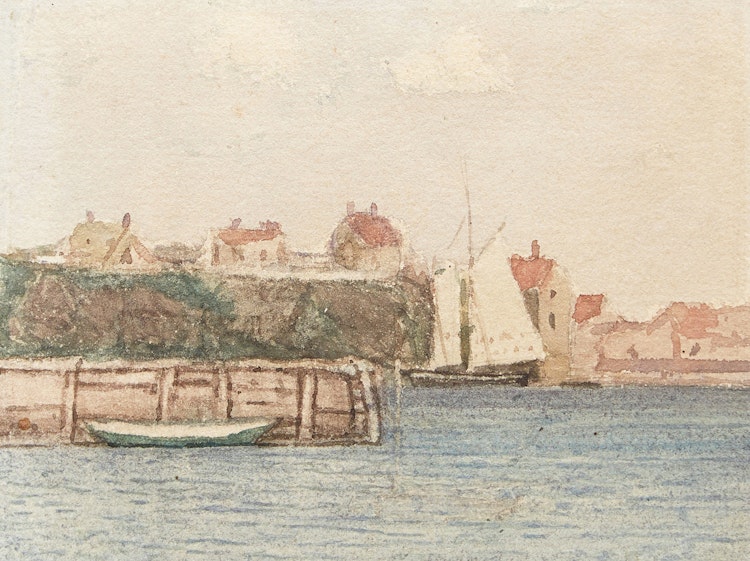At Gloucester by James Wilson Morrice

James Wilson Morrice
At Gloucester
watercolour, laid down on paper
titled in the lower left margin
3.75 x 5 ins ( 9.5 x 12.7 cms ) ( sheet )
Auction Estimate: $5,000.00 - $7,000.00
Price Realized $4,720.00
Sale date: October 26th 2021
Collection of the artist
Maternal family of the artist (circa 1888)
By descent to the present Private Collection, Ontario
Three of the tiny watercolours in this group represent Lake Champlain, and one is dated 1888; in July of that year, the young artist and a brother sojourned in Alburgh, Vermont, just below the Quebec border (”St. Albans Messenger”, July 7). Morrice could have visited Gloucester the same summer, or the year before; certainly before mid-August 1888, when his maternal grandfather, James Anderson, a Scottish miller turned farmer, died in Galt. No doubt the Morrice family from Montreal attended the funerals; and we can imagine the tiny works being sent soon after to Euphemia Anderson, direct ancestor of the present owners. She was the half-sister of Annie, Morrice’s mother; their father had left Scotland in 1857 with both girls, then aged 16 and 6, and his second wife; he had retired to Galt after years in the Brampton area. Perhaps the neat mountings of the watercolours, with some titles inscribed at lower left – a feature also found in the MMFA group – could be the work of a proud mother rather than her son’s. Around 1888, Gloucester, a centuries-old fishing town, was opening up to diversification, with the exploitation of Cape Ann granite. The trains already brought hoards of tourists and some artists, attracted by the exceptional Atlantic light, but the famous art colony was still in the future. Since this is the only Morrice painting found so far with a Massachusetts subject, we presume that Morrice’s stay was more to relax than to work. This unique, perfect watercolour, the size of a postcard, can be seen as a “souvenir”: with very few pencil marks and light colours, the artist immortalized the fishing town and its granite, linked by the tall sailboat, emblem of the seaside resort.
We extend our thanks to Lucie Dorais, Canadian art historian and author of “J.W. Morrice” (National Gallery of Canada, 1985) for contributing the preceding essay.
Share this item with your friends
James Wilson Morrice
(1865 - 1924) RCA
Born in Montreal to a prominent family of textile merchants, Morrice spent most of his life abroad, much of it in Paris. He had gone there to enrol in the Academie Julian, the best-known of the private art schools that lured dozens of young Canadian artists to cross the ocean with the promise of technical proficiency and stylistic sophistication. Soon Morrice was studying with the Barbizon painter Henri Harpignies and looking intently at the pictures of the cutting-edge Nabis members. Affable and gregarious, Morrice was well liked in Paris among the local and emigre vanguard, notably his friends the great Henri Matisse and the influential American painter Robert Henri. He did well, showing in the most prestigious exhibitions of new art, including the Salons, and selling to discerning European collections of the highest rank. If he is remembered mostly in Canada today, it may be because Canadian collectors repatriated most of his pictures after his death, leaving Europeans with little to go on. He had been careful to maintain a reputation at home, showing here regularly and returning frequently for Christmas, which would explain why most of his Canadian pictures are winter scenes. Young Canadian artists held him in considerable esteem during his lifetime for his fearless modernism and his success in Europe. A stylistically hybrid artist, Morrice combined a lush and often dusky Post-Impressionist tone with nonchalant brushwork of a plumb assuredness, softening the blunt structures of his Fauvist friends. What results are paintings as complicated as they are straightforward and often redolent with suppressed emotion. Morrice tends to smallish pictures that draw you in, only to surprise you by their resolute diffidence. Irresistible and remote, his pictures ask for intimacy but keep their distance, like nostalgia, like longing. Morrice ran with a fast crowd of glittering cosmopolitans. Alcoholism got the better of him by the end of his fifties; his health ultimately failed while in North Africa where he had painted with Matisse and where he died at fifty-eight.
Source: National Gallery of Canada

